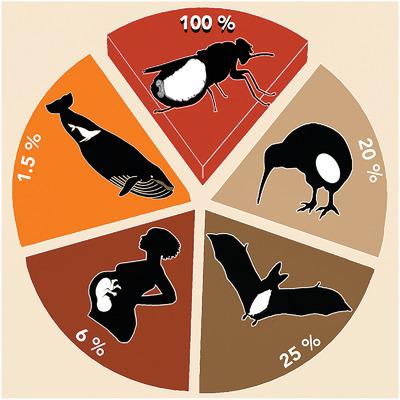Our official English website, www.x-mol.net, welcomes your feedback! (Note: you will need to create a separate account there.)
Big Baby, Little Mother: Tsetse Flies Are Exceptions to the Juvenile Small Size Principle
BioEssays ( IF 4 ) Pub Date : 2020-10-08 , DOI: 10.1002/bies.202000049 Lee R Haines 1 , Glyn A Vale 2, 3 , Antoine M G Barreaux 4 , Norman C Ellstrand 5 , John W Hargrove 2 , Sinead English 4
BioEssays ( IF 4 ) Pub Date : 2020-10-08 , DOI: 10.1002/bies.202000049 Lee R Haines 1 , Glyn A Vale 2, 3 , Antoine M G Barreaux 4 , Norman C Ellstrand 5 , John W Hargrove 2 , Sinead English 4
Affiliation

|
While across the animal kingdom offspring are born smaller than their parents, notable exceptions exist. Several dipteran species belonging to the Hippoboscoidea superfamily can produce offspring larger than themselves. In this essay, the blood‐feeding tsetse is focused on. It is suggested that the extreme reproductive strategy of this fly is enabled by feeding solely on highly nutritious blood, and producing larval offspring that are soft and malleable. This immense reproductive expenditure may have evolved to avoid competition with other biting flies. Tsetse also transmit blood‐borne parasites that cause the fatal diseases called African trypanosomiases. It is discussed how tsetse life history and reproductive strategy profoundly influence the type of vector control interventions used to reduce fly populations. In closing, it is argued that the unusual life history of tsetse warrants their preservation in the areas where human and animal health is not threatened.
中文翻译:

大宝贝,小妈妈:采采蝇是少年小尺寸原则的例外
虽然整个动物王国的后代出生时都比他们的父母小,但也存在明显的例外。属于 Hippoboscoidea 超科的几种双翅目物种可以产生比它们更大的后代。在这篇文章中,我们关注的是吸血采采蝇。这表明这种苍蝇的极端繁殖策略是通过仅以高营养的血液为食,并产生柔软且具有延展性的幼虫后代来实现的。这种巨大的繁殖支出可能是为了避免与其他咬人的苍蝇竞争。采采蝇还传播血源性寄生虫,这些寄生虫会导致称为非洲锥虫病的致命疾病。讨论了采采蝇生活史和繁殖策略如何深刻影响用于减少苍蝇种群的病媒控制干预类型。最后,
更新日期:2020-10-22
中文翻译:

大宝贝,小妈妈:采采蝇是少年小尺寸原则的例外
虽然整个动物王国的后代出生时都比他们的父母小,但也存在明显的例外。属于 Hippoboscoidea 超科的几种双翅目物种可以产生比它们更大的后代。在这篇文章中,我们关注的是吸血采采蝇。这表明这种苍蝇的极端繁殖策略是通过仅以高营养的血液为食,并产生柔软且具有延展性的幼虫后代来实现的。这种巨大的繁殖支出可能是为了避免与其他咬人的苍蝇竞争。采采蝇还传播血源性寄生虫,这些寄生虫会导致称为非洲锥虫病的致命疾病。讨论了采采蝇生活史和繁殖策略如何深刻影响用于减少苍蝇种群的病媒控制干预类型。最后,


























 京公网安备 11010802027423号
京公网安备 11010802027423号